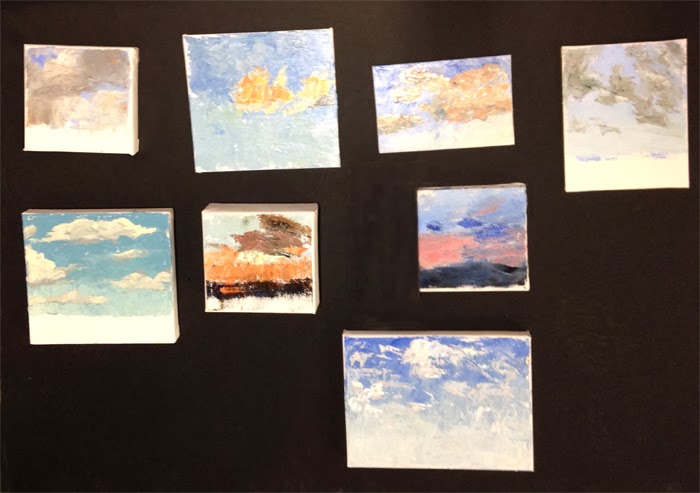Palette knife painting generally does not replicate reality, rather it articulates shapes and colors in a broad, simplified way. By not telling too much of the story (leaving out the details), this abstracted way of applying paint allows viewers to assign their own interpretation to the subject of the painting. It keeps both the artist and the viewer in a more emotional, expressive state.
Saturday, we experimented at the Palette Knife Workshop with our knives and practiced various techniques for painting texture. Alternately, I demonstrated a few techniques and then the ladies went into the teaching room to try them out.
We learned to "turn form" by changing the hue and value of our paint strokes (nothing kills a painting like over blending). By scraping off unwanted paint, we corrected the dull areas of our paintings and applied a new hue or value onto our canvas.
Using the right knife proved to be helpful. A flat knife is a real knuckle dragger while an angled knife lets your fingers grip without hanging down onto the painted surface.
Next, we practiced rendering the gradual transitions of the sky. We divided the sky into two parts: the smooth "atmosphere" and the lumpy "clouds" that float in it.
Learning to differentiate between the smooth, quiet texture of the atmosphere and the greater noise of the clouds took some practice, however each student successfully created a painting.
The abstract landscapes proved to be a greater challenge! Without looking at a reference, each student was instructed to paint from their heart and render a final piece. Aside from a few of us wanting to tear our hair out, this part of the workshop was the most inspiring.
A few tips and pointers:
- To start off, draw a few lines with a small brush to indicate where you will be placing the shapes in your composition. Take the time to get it right.
- Work toward creating color and
texture instead of expecting a
perfect rendition of your subject
matter. Try not to “over think” or
analyze too much.
- Pre-mix some of your colors. Leave them “marbleized” for greater interest. Go ahead and mix colors right on your canvas.
- Keep your knife clean. Wipe it off between colors.
- When you paint with a knife: SIMPLIFY your subject matter. Learn to see general
shapes and large masses of color.
- Work dark to light...thin to thick.
- Don't over blend.
- It’s often effective to apply the paint in one direction then scrape over the passage in
the opposite direction.
- Accidents and irregularities = interest. Knife painting is more loose than brush
painting. Don’t be hard on yourself when your painting looks too wild. You’ll learn to tone it down. It just takes a lot of practice!
- Think about edges and use a variety: hard (crisp), firm, soft and lost edges. There is
no hard-fast rule about edges. Sometimes soft edges can make distant objects
appear farther away, but too many soft edges can turn your background into a foggy
mess!
- Look for unwanted patterns and interrupt them with a lost edge or a new color.
- Watch the size of the textures that you create. Generally, objects in the distance have little or no texture while subject matter in the foreground has larger, more contrasting texture.
- Think in layers. “What’s behind or underneath?”
Miscellaneous
When painting with a knife you might need to turn your canvas to get the right angle for placing a stroke. I have learned to turn my wrist or hand, or even use my other hand to articulate a stroke.
The stroke of a knife does not produce uniform edges. One side of your stroke might have a hard edge while the other side might have a softer edge. Sometimes you can place a new knife stroke over part of the old one, and sculpt it into the exact shape you want. Learning to manipulate your knife can be tricky, but it’s rewarding when you get it right.
The strokes from a knife are more bold than those from a brush. The flat surface of a knife stroke usually makes the color of the pigment read with more intensity than a brush stroke with it’s many bristle marks. Also, the thickness of a few well-placed knife strokes can give your painting a three dimensional feel.
Experiment with your palette knife. Try combining your brushwork with lively knife work and see what happens.
Have some fun!

























No comments:
Post a Comment